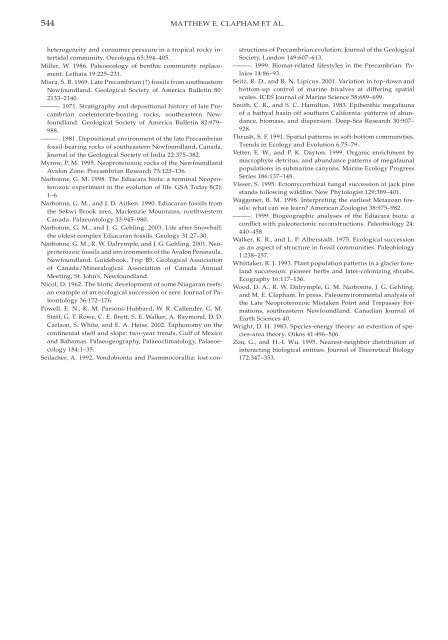Paleoecology of the oldest known animal communities: Ediacaran ...
Paleoecology of the oldest known animal communities: Ediacaran ...
Paleoecology of the oldest known animal communities: Ediacaran ...
You also want an ePaper? Increase the reach of your titles
YUMPU automatically turns print PDFs into web optimized ePapers that Google loves.
544 MATTHEW E. CLAPHAM ET AL.<br />
heterogeneity and consumer pressure in a tropical rocky intertidal<br />
community. Oecologia 65:394–405.<br />
Miller, W. 1986. <strong>Paleoecology</strong> <strong>of</strong> benthic community replacement.<br />
Lethaia 19:225–231.<br />
Misra, S. B. 1969. Late Precambrian (?) fossils from sou<strong>the</strong>astern<br />
Newfoundland. Geological Society <strong>of</strong> America Bulletin 80:<br />
2133–2140.<br />
———. 1971. Stratigraphy and depositional history <strong>of</strong> late Precambrian<br />
coelenterate-bearing rocks, sou<strong>the</strong>astern Newfoundland.<br />
Geological Society <strong>of</strong> America Bulletin 82:979–<br />
988.<br />
———. 1981. Depositional environment <strong>of</strong> <strong>the</strong> late Precambrian<br />
fossil-bearing rocks <strong>of</strong> sou<strong>the</strong>astern Newfoundland, Canada.<br />
Journal <strong>of</strong> <strong>the</strong> Geological Society <strong>of</strong> India 22:375–382.<br />
Myrow, P. M. 1995. Neoproterozoic rocks <strong>of</strong> <strong>the</strong> Newfoundland<br />
Avalon Zone. Precambrian Research 73:123–136.<br />
Narbonne, G. M. 1998. The Ediacara biota: a terminal Neoproterozoic<br />
experiment in <strong>the</strong> evolution <strong>of</strong> life. GSA Today 8(2):<br />
1–6.<br />
Narbonne, G. M., and J. D. Aitken. 1990. <strong>Ediacaran</strong> fossils from<br />
<strong>the</strong> Sekwi Brook area, Mackenzie Mountains, northwestern<br />
Canada. Palaeontology 33:945–980.<br />
Narbonne, G. M., and J. G. Gehling. 2003. Life after Snowball:<br />
<strong>the</strong> <strong>oldest</strong> complex <strong>Ediacaran</strong> fossils. Geology 31:27–30.<br />
Narbonne, G. M., R. W. Dalrymple, and J. G. Gehling. 2001. Neoproterozoic<br />
fossils and environments <strong>of</strong> <strong>the</strong> Avalon Peninsula,<br />
Newfoundland. Guidebook, Trip B5, Geological Association<br />
<strong>of</strong> Canada/Mineralogical Association <strong>of</strong> Canada Annual<br />
Meeting, St. John’s, Newfoundland.<br />
Nicol, D. 1962. The biotic development <strong>of</strong> some Niagaran reefs:<br />
an example <strong>of</strong> an ecological succession or sere. Journal <strong>of</strong> Paleontology<br />
36:172–176.<br />
Powell, E. N., K. M. Parsons-Hubbard, W. R. Callender, G. M.<br />
Staff, G. T. Rowe, C. E. Brett, S. E. Walker, A. Raymond, D. D.<br />
Carlson, S. White, and E. A. Heise. 2002. Taphonomy on <strong>the</strong><br />
continental shelf and slope: two-year trends, Gulf <strong>of</strong> Mexico<br />
and Bahamas. Palaeogeography, Palaeoclimatology, Palaeoecology<br />
184:1–35.<br />
Seilacher, A. 1992. Vendobionta and Psammocorallia: lost constructions<br />
<strong>of</strong> Precambrian evolution. Journal <strong>of</strong> <strong>the</strong> Geological<br />
Society, London 149:607–613.<br />
———. 1999. Biomat-related lifestyles in <strong>the</strong> Precambrian. Palaios<br />
14:86–93.<br />
Seitz, R. D., and R. N. Lipicus. 2001. Variation in top-down and<br />
bottom-up control <strong>of</strong> marine bivalves at differing spatial<br />
scales. ICES Journal <strong>of</strong> Marine Science 58:689–699.<br />
Smith, C. R., and S. C. Hamilton. 1983. Epibenthic megafauna<br />
<strong>of</strong> a bathyal basin <strong>of</strong>f sou<strong>the</strong>rn California: patterns <strong>of</strong> abundance,<br />
biomass, and dispersion. Deep-Sea Research 30:907–<br />
928.<br />
Thrush, S. F. 1991. Spatial patterns in s<strong>of</strong>t-bottom <strong>communities</strong>.<br />
Trends in Ecology and Evolution 6:75–79.<br />
Vetter, E. W., and P. K. Dayton. 1999. Organic enrichment by<br />
macrophyte detritus, and abundance patterns <strong>of</strong> megafaunal<br />
populations in submarine canyons. Marine Ecology Progress<br />
Series 186:137–148.<br />
Visser, S. 1995. Ectomycorrhizal fungal succession in jack pine<br />
stands following wildfire. New Phytologist 129:389–401.<br />
Waggoner, B. M. 1998. Interpreting <strong>the</strong> earliest Metazoan fossils:<br />
what can we learn? American Zoologist 38:975–982.<br />
———. 1999. Biogeographic analyses <strong>of</strong> <strong>the</strong> Ediacara biota: a<br />
conflict with paleotectonic reconstructions. Paleobiology 24:<br />
440–458.<br />
Walker, K. R., and L. P. Alberstadt. 1975. Ecological succession<br />
as an aspect <strong>of</strong> structure in fossil <strong>communities</strong>. Paleobiology<br />
1:238–257.<br />
Whittaker, R. J. 1993. Plant population patterns in a glacier foreland<br />
succession: pioneer herbs and later-colonizing shrubs.<br />
Ecography 16:117–136.<br />
Wood, D. A., R. W. Dalrymple, G. M. Narbonne, J. G. Gehling,<br />
and M. E. Clapham. In press. Paleoenvironmental analysis <strong>of</strong><br />
<strong>the</strong> Late Neoproterozoic Mistaken Point and Trepassey Formations,<br />
sou<strong>the</strong>astern Newfoundland. Canadian Journal <strong>of</strong><br />
Earth Sciences 40.<br />
Wright, D. H. 1983. Species-energy <strong>the</strong>ory: an extention <strong>of</strong> species-area<br />
<strong>the</strong>ory. Oikos 41:496–506.<br />
Zou, G., and H.-I. Wu. 1995. Nearest-neighbor distribution <strong>of</strong><br />
interacting biological entities. Journal <strong>of</strong> Theoretical Biology<br />
172:347–353.

















